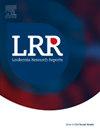AL amyloidosis with elevated peripheral blood cell counts – A frequent association with liver involvement. A single-center retrospective study
IF 0.9
Q4 HEMATOLOGY
引用次数: 0
Abstract
Background
AL amyloidosis is a systemic protein misfolding disorder characterized by organ deposition of monoclonal immunoglobulin fragments, with insidious onset and progressive course. The plasma cell clone in the bone marrow is relatively small and typically does not impair hematopoiesis, in contrast to multiple myeloma. Herein we present a novel observation of increased thrombocyte, leukocyte and erythrocyte counts in a subset of AL amyloidosis patients.
Material and Methods
We performed a retrospective analysis of medical records of all consecutive patients diagnosed with AL amyloidosis at the Medical University of Warsaw in years 2001–2022, which included clinical, pathological and laboratory data, as well as treatment protocols and outcomes.
Results
Twenty-three patients out of 124 (18.4 %) included had elevated blood counts: 17 (13.6 %) had leukocytosis with neutrophilia, 7 (5.6 %) had thrombocytosis, whereas 2 (1.6 %) had erythrocytosis. In comparison to the remaining AL population this subgroup was characterized by younger age (median 57 vs 62 years, p = 0.018), higher frequency of hepatomegaly (42.9 % vs.14.7 %, p = 0.004), higher median alkaline phosphatase concentration (129 U/L vs 93 U/L, p = 0.006) and more frequent hepatic amyloidosis (34.8 % vs 10.3 %, p = 0.003). None of the patients had definite features of a myeloproliferative neoplasm, although genetic testing was available in 5 out of 9 cases with thrombocytosis or erythrocytosis. There were no significant differences in terms of survival between patients with elevated cell counts and non-polycythemic patients (median overall survival 2.9 vs 6.6 years, p = 0.51, median event-free survival 0.7 vs 1.8 years, p = 0.29, respectively).
Conclusions
Elevated peripheral blood counts in a subset of patients with AL amyloidosis constitute a rare but significant phenomenon and appear to be associated with frequent hepatic involvement. We hypothesize that cytokine deregulation and hyposplenism may belong to its pathomechanisms.
AL淀粉样变伴外周血细胞计数升高-常与肝脏受累有关。单中心回顾性研究
背景:淀粉样变性是一种以单克隆免疫球蛋白片段器官沉积为特征的全身性蛋白质错误折叠疾病,发病隐匿,病程渐进。与多发性骨髓瘤相比,骨髓中的浆细胞克隆相对较小,通常不会损害造血功能。在这里,我们提出了一个新的观察增加的血小板,白细胞和红细胞计数在一个子集AL淀粉样变性患者。材料和方法我们对2001-2022年在华沙医科大学诊断为AL淀粉样变性的所有连续患者的医疗记录进行了回顾性分析,包括临床、病理和实验室数据,以及治疗方案和结果。结果124例患者中23例(18.4%)出现血球计数增高,其中白细胞增多伴中性粒细胞增多17例(13.6%),血小板增多7例(5.6%),红细胞增多2例(1.6%)。与其他AL人群相比,该亚组的特点是年龄更年轻(中位57岁对62岁,p = 0.018),肝肥大发生率更高(42.9%对14.7%,p = 0.004),碱性磷酸酶中位浓度更高(129 U/L对93 U/L, p = 0.006),肝淀粉样变发生率更高(34.8%对10.3%,p = 0.003)。虽然9例有血小板增多或红细胞增多的患者中有5例进行了基因检测,但没有一例患者具有骨髓增生性肿瘤的明确特征。细胞计数升高的患者和非红细胞增多症患者的生存期没有显著差异(中位总生存期为2.9年vs 6.6年,p = 0.51,中位无事件生存期为0.7年vs 1.8年,p = 0.29)。结论:AL淀粉样变患者的外周血计数升高是一种罕见但重要的现象,似乎与频繁的肝脏受累有关。我们推测细胞因子失调和脾功能减退可能属于其病理机制。
本文章由计算机程序翻译,如有差异,请以英文原文为准。
求助全文
约1分钟内获得全文
求助全文

 求助内容:
求助内容: 应助结果提醒方式:
应助结果提醒方式:


